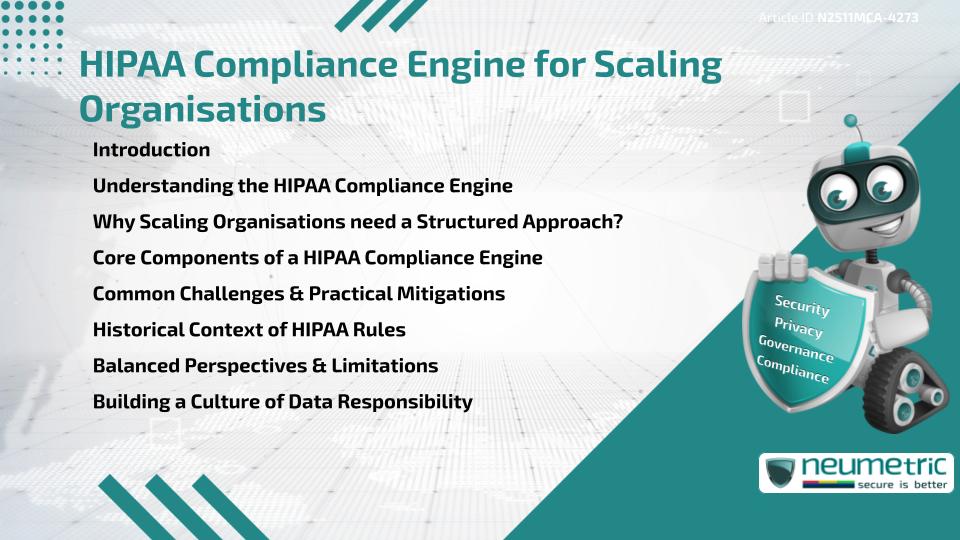Table of Contents
ToggleIntroduction
The HIPAA Compliance engine helps Scaling Organisations protect Health Information, manage Operational Risk & maintain Organisational Trust. This Article explains how the HIPAA Compliance engine works, how it supports Regulated workflows & why Scaling Organisations rely on it to meet Privacy & Security requirements. It also outlines key components, common challenges, historical context & practical mitigation strategies that influence everyday Compliance efforts. Readers gain a complete overview that combines clarity, practicality & balanced perspectives.
Understanding the HIPAA Compliance Engine
A HIPAA Compliance engine acts as an organised Workflow System that links Policies, Training, Oversight & Documentation. It guides Teams through requirements so they know what to do & when to act. A helpful comparison is a navigation tool that translates regulations into predictable steps. Instead of leaving interpretation to chance the engine aligns Administrative tasks & Technical safeguards in one structured process.
Why Scaling Organisations need a Structured Approach?
When organisations grow they add new Systems, Staff & Service Providers. A HIPAA Compliance engine supports this expansion by standardising documentation & providing repeatable steps. It removes confusion & encourages clear responsibility so each Team understands its role. Without this structure important tasks such as Training, Incident Response & Access Oversight may be missed or misunderstood.
Core Components of a HIPAA Compliance Engine
A HIPAA Compliance engine usually includes Policy Libraries, Training Modules, Audit Logs, Risk Assessment Workflows & Reporting Dashboards. Each component supports a distinct Operational requirement. A simple analogy is a toolbox where every tool performs a specific job. Combined they create a complete system that helps maintain consistent Organisational Standards.
Common Challenges & Practical Mitigations
Scaling Organisations often encounter challenges such as limited training time, rapid system updates & inconsistent communication. A HIPAA Compliance engine reduces these issues by offering standardised processes that improve visibility & clarity. It cannot eliminate every obstacle but it reduces uncertainty by documenting expectations in an accessible & easy-to-follow format.
Historical Context of HIPAA Rules
The Health Insurance Portability & Accountability Act was introduced to protect Health information & ensure continued coverage for Individuals. Over time its rules expanded to include Privacy & Security requirements. Understanding this background explains why the HIPAA Compliance engine must incorporate Administrative safeguards, Technical protections & Ongoing monitoring. This context also highlights the need for continuous awareness within all Teams.
Balanced Perspectives & Limitations
A HIPAA Compliance engine provides structure but it is not a substitute for responsible behaviour or informed leadership. It organises tasks yet Human judgement remains essential. Some Organisations may find the system restrictive if they depend on informal decision-making. Others appreciate the clarity it provides. The primary limitation is that no tool can predict every real-world situation.
Building a Culture of Data Responsibility
A HIPAA Compliance engine functions best when Organisations value responsibility. Teams need Awareness, Open Communication & a shared commitment to protecting Health Information. Straightforward habits such as regular Training, periodic Risk reviews & Open Discussions strengthen this culture. The engine reinforces these habits by clarifying Expectations & simplifying Procedures.
Takeaways
- A HIPAA Compliance engine supports Organisational growth by structuring Compliance Tasks.
- It simplifies Training & Documentation for Scaling Organisations.
- It clarifies expectations for Staff & Leaders.
- It explains key historical influences on Compliance rules.
- It encourages a practical culture of responsibility.
FAQ
What is a HIPAA Compliance engine?
A HIPAA Compliance engine is a structured workflow tool that guides Organisations through Privacy & Security requirements.
How does a HIPAA Compliance engine improve Operational clarity?
It standardises Processes so Staff understand Tasks, Responsibilities & Compliance expectations.
Does a HIPAA Compliance engine replace Human judgement?
No. It supports Decision-making but Teams must still apply their own Judgement & Experience.
Why do Scaling Organisations rely on a HIPAA Compliance engine?
Growth brings complexity & the engine helps maintain structure, clarity & oversight.
Is Training included in most HIPAA Compliance Engine Systems?
Yes. Training modules are commonly included to strengthen Awareness & Accountability.
Need help for Security, Privacy, Governance & VAPT?
Neumetric provides organisations the necessary help to achieve their Cybersecurity, Compliance, Governance, Privacy, Certifications & Pentesting needs.
Organisations & Businesses, specifically those which provide SaaS & AI Solutions in the Fintech, BFSI & other regulated sectors, usually need a Cybersecurity Partner for meeting & maintaining the ongoing Security & Privacy needs & requirements of their Enterprise Clients & Privacy conscious Customers.
SOC 2, ISO 27001, ISO 42001, NIST, HIPAA, HECVAT, EU GDPR are some of the Frameworks that are served by Fusion – a SaaS, multimodular, multitenant, centralised, automated, Cybersecurity & Compliance Management system.
Neumetric also provides Expert Services for technical security which covers VAPT for Web Applications, APIs, iOS & Android Mobile Apps, Security Testing for AWS & other Cloud Environments & Cloud Infrastructure & other similar scopes.
Reach out to us by Email or filling out the Contact Form…


